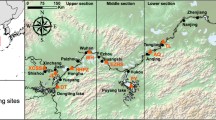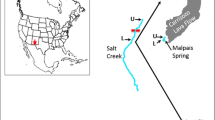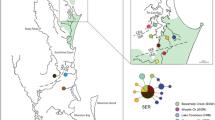Abstract
Distinguishing the relative influence of historic (i.e. natural) versus anthropogenic factors in metapopulation structure is an important but often overlooked step in management programs of threatened species. Biotas in freshwater wetlands and floodplains, such as those in the Murray–Darling Basin (MDB)—one of Australia’s most impacted ecosystems, are particularly susceptible to anthropogenic fragmentation. Here we present a comprehensive multilocus assessment of genetic variation in the threatened southern pygmy perch Nannoperca australis (578 individuals; 45 localities; microsatellite, allozyme and mitochondrial DNA datasets), an ecological specialist with low dispersal potential. We assess patterns of spatial structure and genetic diversity in populations spanning the highly fragmented MDB and test whether recent anthropogenic modification has disrupted range-wide connectivity. We detected strong and hierarchical population structure, very low genetic diversity and lack of contemporary gene flow across the MDB. In contrast, the apparent absence of pronounced or long-term phylogeographic structure suggests that observed population divergences generally do not reflect deeply historic natural fragmentation. Coalescent-based analyses supported this inference, revealing that divergence times between populations from the upper and lower MDB fall into the period of European settlement. It appears that the observed contemporary isolation of populations is partly explained by the severe modification of the MDB post-dating the onset of European settlement. Our integrated approach substantially improves the interpretation of how fragmentation impacts present-day biodiversity. It also provides novel contributions for risk-assessing management actions in the context of captive breeding and translocations of small freshwater fishes, a group of increasing global conservation concern.





Similar content being viewed by others
References
Attard C, Moller L, Sasaki M, Hammer MP, Bice C, Brauer C, Carvalho D, Harris J, Beheregaray LB (2016) A novel holistic framework for genetic-based reintroduction programs. Conserv Biol. doi:10.1111/cobi.12699
Brauer CJ, Unmack PJ, Hammer MP, Adams M, Beheregaray LB (2013) Catchment-scale conservation units identified for the threatened Yarra pygmy perch (Nannoperca obscura) in highly modified river systems. PLoS One 8:e82953
Carvalho DC, Hammer MP, Beheregaray LB (2012) Isolation and PCR-multiplex genotyping of 18 novel microsatellite markers for the threatened southern pygmy perch (Nannoperca australis). Conserv Genet Resour 4:15–17
Clement M, Posada D, Crandall KA (2000) TCS: a computer program to estimate gene genealogies. Mol Ecol 9:1657–1659
Cook BD, Bunn SE, Hughes JM (2007) Molecular genetic and stable isotope signatures reveal complementary patterns of population connectivity in the regionally vulnerable southern pygmy perch (Nannoperca australis). Biol Conserv 138:60–72
Coombs JA, Letcher BH, Nislow KH (2008) CREATE: a software to create input files from diploid genotypic data for 52 genetic software programs. Mol Ecol Resour 8:578–580
Corander J, Sirén J, Arjas E (2008) Bayesian spatial modeling of genetic population structure. Comput Stat 23:111–129
Cornuet JM, Luikart G (1996) Description and power analysis of two tests for detecting recent population bottlenecks from allele frequency data. Genetics 144:2001–2014
Cornuet JM, Pudlo P, Veyssier J, Dehne-Garcia A et al (2014) DIYABC v2.0: a software to make approximate Bayesian computation inferences about population history using single nucleotide polymorphism, DNA se quence and microsatellite data. Bioinformatics 30:1187–1189
Dawkins KL, Furse JM, Wild CH, Hughes JM (2010) Distribution and population genetics of the threatened freshwater crayfish genus Tenuibranchiurus (Decapoda: Parastacidae). Mar Freshw Res 61:1048–1055
DeWoody JA, Avise JC (2000) Microsatellite variation in marine, freshwater and anadromous fishes compared with other animals. J Fish Biol 56:461–473
Driscoll DA (1998) Genetic structure, metapopulation processes and evolution influence the conservation strategies for two endangered frog species. Biol Conserv 83:43–54
Evanno G, Regnaut S, Goudet J (2005) Detecting the number of clusters of individuals using the software STRUCTURE: a simulation study. Mol Ecol 14:2611–2620
Excoffier L, Smouse PE, Quattro JM (1992) Analysis of molecular variance inferred from metric distances among DNA haplotypes: application to human mitochondrial DNA restriction data. Genetics 131:479–491
Fagan WF (2002) Connectivity, fragmentation, and extinction risk in dendritic metapopulations. Ecology 83:3243–3249
Fagan WF, Aumann C, Kennedy CM, Unmack PJ (2005) Rarity, fragmentation, and the scale dependence of extinction risk in desert fishes. Ecology 86:34–41
Faulks LK, Gilligan DM, Beheregaray LB (2010) Islands of water in a sea of dry land: hydrological regime predicts genetic diversity and dispersal in a widespread fish from Australia’s arid zone, the golden perch (Macquaria ambigua). Mol Ecol 19:4723–4737
Faulks LK, Gilligan DM, Beheregaray LB (2011) The role of anthropogenic vs. natural in-stream structures in determining connectivity and genetic diversity in an endangered freshwater fish, Macquarie perch (Macquaria australasica). Evol Appl 4:589–601
Fischer J, Lindenmayer DB (2007) Landscape modification and habitat fragmentation: a synthesis. Glob Ecol Biogeogr 16:265–280
Garza JC, Williamson EG (2001) Detection of reduction in population size using data from microsatellite loci. Mol Ecol 10:305–318
Geist J (2011) Integrative freshwater ecology and biodiversity conservation. Ecol Ind 11:1507–1516
Hammer MP, Wedderburn S, Van Weenen J (2009) Action Plan for South Australian Freshwater Fishes. Department for Environment and Heritage, Government of South Australia. Native Fish Australia (SA) Inc., Australia
Hammer MP, Bice CM, Hall A, Frears A, Watt A, Whiterod NS, Beheregaray LB, Harris JO, Zampatti BP (2013) Freshwater fish conservation in the face of critical water shortages in the southern Murray–Darling Basin, Australia. Mar Freshw Res 64:807–821
Hanski I, Gaggiotti O (2004) Ecology, genetics, and evolution of metapopulations. In: Hanski I, Gaggiotti O (eds) Elsevier. Academic Press, Amsterdam, p 696
Hardy OJ, Vekemans X (2002) SPAGeDi: a versatile computer program to analyse spatial genetic structure at the individual or population levels. Mol Ecol Notes 2:618–620
Hey J (2010) Isolation with migration models for more than two populations. Mol Biol Evol 27:905–920
Hill JK, Hughes CL, Dytham C, Searle JB (2006) Genetic diversity in butterflies: interactive effects of habitat fragmentation and climate-driven range expansion. Biol Lett 2:152–154
Huey JA, Baker AM, Hughes JM (2010) High levels of genetic structure in the Australian freshwater fish, Ambassis macleayi. J N Am Benthol Soc 29:1148–1160
Hughes JM (2007) Constraints on recovery: using molecular methods to study connectivity of aquatic biota in rivers and streams. Freshw Biol 52:616–631
James KR, Cant B, Ryan T (2003) Responses of freshwater biota to rising salinity levels and implications for saline water management: a review. Aust J Bot 51:703–713
Kang B, He D, Perrett L, Wang H, Hu W, Deng W, Wu Y (2009) Fish and fisheries in the Upper Mekong: current assessment of the fish community, threats and conservation. Rev Fish Biol Fish 19:465–480
Lande R (1988) Genetics and demography in biological conservation. Science 241:1455–1460
Lankau R, Jørgensen PS, Harris DJ, Sih A (2011) Incorporating evolutionary principles into environmental management and policy. Evol Appl 4:315–325
Laurance WF, Dell B, Turton SM, Lawes MJ, Hutley LB, McCallum H, Dale P, Bird M, Hardy G, Prideaux G, Gawne B, McMahon CR, Yu R, Hero J, Schwarzkopf L, Krockenberger A, Douglas M, Silvester E, Mahony M, Vella K, Saikia U, Wahren C, Xu Z, Smith B, Cocklin C (2011) The 10 Australian ecosystems most vulnerable to tipping points. Biol Conserv 144:1472–1480
Leblanc M, Tweed S, Van Dijk A, Timbal B (2012) A review of historic and future hydrological changes in the Murray–Darling Basin. Global Planet Chang 80:226–246
Lintermans M (2007) Fishes of the Murray–Darling Basin: An introductory guide. Murray–Darling Basin Authority, Canberra
Llewellyn LC (1974) Spawning, development and distribution of the southern pigmy perch Nannoperca australis australis Gunther from inland waters in eastern Australia. Mar Freshw Res 25:121–149
Marko PB, Hart MW (2011) The complex analytical landscape of gene flow inference. Trends Ecol Evol 26:448–456
Meirmans PG (2012) The trouble with isolation by distance. Mol Ecol 21:2839–2846
Meirmans PG, Van Tienderen PH (2004) GENOTYPE and GENODIVE: two programs for the analysis of genetic diversity of asexual organisms. Mol Ecol Notes 4:792–794
Moritz C, McGuigan K, Bernatchez L (2002) Conservation of freshwater fishes: integrating evolution and genetics with ecology. In: Collares-Pereira MJ, Coelho M (eds) Freshwater fish conservation. Options for the future. Fishing News Books, Blackwell Science, Oxford, pp 293–310
Nielsen R, Wakeley J (2001) Distinguishing migration from isolation: a Markov chain Monte Carlo approach. Genetics 158:885–896
Palmer MA, Reidy Liermann CA, Nilsson C, Flörke M, Alcamo J, Lake PS, Bond N (2008) Climate change and the world’s river basins: anticipating management options. Front Ecol Environ 6:81–89
Peakall R, Smouse PE (2012) GenAlEx 6.5: genetic analysis in Excel. Population genetic software for teaching and research—an update. Bioinformatics 28:2537–2539
Philippart JC (1995) Is captive breeding an effective solution for the preservation of endemic species? Biol Conserv 72:281–295
Piry S, Alapetite A, Cornuet JM, Paetkau D, Baudouin L, Estoup A (2004) GENECLASS2: a software for genetic assignment and first-generation migrant detection. J Hered 95:536–539
Poff NL, Allan JD, Bain MB, Karr JR, Prestegaard KL, Richter BD, Sparks RE, Stromberg JC (1997) The natural flow regime. Bioscience 47:769–784
Pritchard JK, Stephens M, Donnelly P (2000) Inference of population structure using multilocus genotype data. Genetics 155:945–959
Pritchard VL, Metcalf JL, Jones K, Martin AP, Cowley DE (2009) Population structure and genetic management of Rio Grande cutthroat trout (Oncorhynchus clarkii virginalis). Conserv Genet 10:1209–1221
Puckridge JT, Sheldon F, Walker KF, Boulton AJ (1998) Flow variability and the ecology of large rivers. Mar Freshw Res 49:55–72
Rannala B, Mountain JL (1997) Detecting immigration by using multilocus genotypes. Proc Natl Acad Sci 94:9197–9201
Sgrò CM, Lowe AJ, Hoffmann AA (2011) Building evolutionary resilience for conserving biodiversity under climate change. Evol Appl 4:326–337
Spielman D, Brook BW, Frankham R (2004) Most species are not driven to extinction before genetic factors impact them. Proc Natl Acad Sci 101:15261–15264
Teske PR, Sandoval-Castillo J, Waters JM, Beheregaray LB (2014) Can novel genetic analyses help to identify low-dispersal marine invasive species? Ecol Evol 4:2848–2866
Tonkin Z, King AJ, Mahoney J (2008) Effects of flooding on recruitment and dispersal of the Southern Pygmy Perch (Nannoperca australis) at a Murray River floodplain wetland. Ecol Manag Restor 9:196–201
Unmack PJ, Hammer MP, Adams M, Johnson JB, Dowling TE (2013) The role of continental shelf width in determining freshwater phylogeographic patterns in south-eastern Australian pygmy perches (Teleostei: Percichthyidae). Mol Ecol 22:1683–1699
Van Oosterhout C, Hutchinson WF, Wills DP, Shipley P (2004) MICRO-CHECKER: software for identifying and correcting genotyping errors in microsatellite data. Mol Ecol Notes 4:535–538
Walker KF, Thoms MC (1993) Environmental effects of flow regulation on the River Murray, South Australia. Regul Rivers 8:103–119
Wedderburn SD, Hammer MP, Bice CM (2012) Shifts in small-bodied fish assemblages resulting from drought-induced water level recession in terminating lakes of the Murray–Darling Basin, Australia. Hydrobiologia 691:35–46
Weeks AR, Sgró CM, Young AG, Frankham R, Mitchell NJ, Miller KA, Byrne M, Coates DJ, Eldridge MDB, Sunnucks P, Breed MF, James EA, Hoffmann AA (2011) Assessing the benefits and risks of translocations in changing environments: a genetic perspective. Evol Appl 4:709–725
Willi Y, van Buskirk J, Hoffmann AA (2006) Limits to the adaptive potential of small populations. Annu Rev Ecol Evol Syst 37:433–478
Wilson GA, Rannala B (2003) Bayesian inference of recent migration rates using multilocus genotypes. Genetics 163:1177–1191
Wright S (1942) Isolation by Distance. Genetics 28:114–138
Yue GH, David L, Orban L (2007) Mutation rate and pattern of microsatellites in common carp (Cyprinus carpio L.). Genetica 129:329–331
Acknowledgments
We thank the many people who helped with fieldwork, and are grateful to Minami Sasaki and Jerald Johnson for laboratory assistance. Collections were obtained under permits from various state fisheries agencies and research is under Flinders University Animal Welfare Committee approval E313. Financial support was provided by the Australian Research Council (LP100200409 to LB Beheregaray, J Harris and M Adams; and FT130101068 to LB Beheregaray) and by an AJ & IM Naylon Honours scholarship (to TL Cole).
Author information
Authors and Affiliations
Corresponding author
Ethics declarations
Conflict of interest
The authors declare that they have no conflict of interest.
Electronic supplementary material
Below is the link to the electronic supplementary material.
Rights and permissions
About this article
Cite this article
Cole, T.L., Hammer, M.P., Unmack, P.J. et al. Range-wide fragmentation in a threatened fish associated with post-European settlement modification in the Murray–Darling Basin, Australia. Conserv Genet 17, 1377–1391 (2016). https://doi.org/10.1007/s10592-016-0868-8
Received:
Accepted:
Published:
Issue Date:
DOI: https://doi.org/10.1007/s10592-016-0868-8




